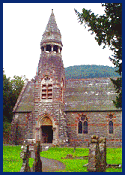
Church and chapel 7
The pressure for change
High church influence
The Oxford movement which sought to introduce some of the ritual to the practices of worship had an influence in the long term.
Churches like the new parish church at Abbey Cwmhir in Radnorshire
(left) reflect some of the High Church influence of this
time.
to the practices of worship had an influence in the long term.
Churches like the new parish church at Abbey Cwmhir in Radnorshire
(left) reflect some of the High Church influence of this
time.
The nonconformists’ resentment at having to pay tithes to
a church they had rejected, and their increasing local power
through elections onto new local government bodies all put further
pressure onto the established church in Wales.
After much bitter debate a separate Church in Wales was created in 1920, which was not part of the state and which lost much of its wealth. Soon after, Bishop Alfred Edwards of St. Asaph was chosen as the first Archbishop of Wales. In 1923 the new Province of Wales created the diocese of Swansea and Brecon from parts of the sprawling diocese of St David’s, and a new diocese of Monmouth was created out of parts of the industrial populations of the diocese of Llandaff.
New English arrivals
During the nineteenth century the nonconformist denominations
had to respond to the large English or English-speaking influx
intoWales as the rapidly growing  industries
recruited a larger workforce. The Calvinistic Methodists and
Independents established new English medium chapels. In the new
urban centres chapels were built which were increasingly grand
in scale, like the typical example shown (right) in Ystradgynlais,
and chapels became a focal point for social activities in the
community. Through their active Sunday schools they also played
an important role in local education.
industries
recruited a larger workforce. The Calvinistic Methodists and
Independents established new English medium chapels. In the new
urban centres chapels were built which were increasingly grand
in scale, like the typical example shown (right) in Ystradgynlais,
and chapels became a focal point for social activities in the
community. Through their active Sunday schools they also played
an important role in local education.
There are 8 pages in this sequence. Use the box links below to view the other pages.